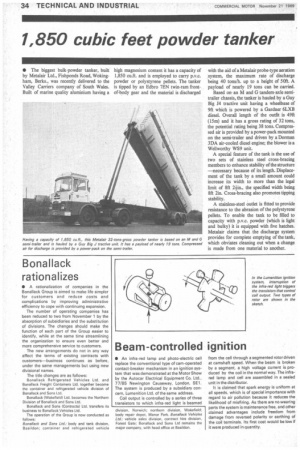1,850 cubic feet powder tanker
Page 36

If you've noticed an error in this article please click here to report it so we can fix it.
• The biggest bulk-powder tanker, built by Metalair Ltd., Fishponds Road, Wokingham, Berks., was recently delivered to the Valley Carriers company of South Wales. Built of marine quality aluminium having a high magnesium content it has a capacity of 1,850 cuff. and is employed to carry p.v.c. powder or polystyrene pellets. The tanker is tipped by an Edbro 7EN twin-ram frontof-body gear and the material is discharged with the aid of a Metalair probe-type aeration system, the maximum rate of discharge being 40 tons/h. up to a height of 50ft. A payload of nearly 19 tons can be carried.
Based on, an M and G tandem-axle semitrailer chassis, the tanker is hauled by a Guy Big J4 tractive unit having a wheelbase of 9ft which is powered by a Gardner 6LXB diesel. Overall length of the outfit is 49ft (15m) and it has a gross rating of 32 tons, the potential rating being 38 tons. Compressed air is provided by a power-pack mounted on the semi-trailer and driven by a Dorman 3DA air-cooled diesel engine; the blower is a Wellworthy WS9 unit.
A special feature of the tank is the use of two sets of stainless steel cross-bracing members to enhance stability of the structure —necessary because of its length. Displacement of the tank by a small amount could increase its width to more than the legal limit of 8ft 2iin., the specified width being 8ft 2in. Cross-bracing also promotes tipping stability.
A stainless-steel outlet is fitted to provide resistance to the abrasion of the polystyrene pellets. To enable the tank to be filled to capacity with p.v.c. powder (which is light and bulky) it is equipped with five hatches. Metalair claims that the discharge system provides for complete emptying of the tank, which obviates cleaning out when a change is made from one material to another.




































































































